Unfortunately, domestic assault is an all too common occurrence in Minnesota. If you suddenly find yourself charged with domestic violence, you need to take it very seriously, and you need to understand what you’re up against.
One of the most common things that tends to occur when domestic violence charges are filed is that the accused will be hit with a protective order of some kind. There are a couple different types of protective orders available in the state of Minnesota, but in general the purpose of all of them is to prevent the individual accused of domestic violence from contacting his or her alleged victim.
Violate a protective order and you can find yourself facing even more severe penalties, so it is vital that you understand what the different kinds of orders require of you.
The Two Kinds of Protective Orders in Minnesota
In our state, there are two different kinds of protective orders – the ex parte order and the full order.
Ex Parte Order
Ex parte is a Latin term that translates to “on one side only.” What this means where protective orders are concerned is that it can be issued by a judge without your presence or knowledge. In other words, you might have a legally binding ex parte order against you and have no idea until you are served with it.
In Minnesota, this type of order is also known as an ex parte temporary order of protection. What does temporary mean? That this order is in effect for a specific, fixed period of time. Generally in our state, ex parte orders can last for up to two years.
Why are these orders put in place? The alleged victim has to go to court and convince the judge that they are in danger of “immediate and present” domestic abuse.
Is there anything that you can do about it if you disagree? Yes. You can request a hearing to have the order revoked. If you decide to do this, the hearing is required to take place within 10 days of when the court receives the request – unless either side requests a continuance. At this hearing, it is then up to the alleged victim to present evidence detailing why the order should remain in effect.
Full Order
Unlike with an ex parte order, the court is required to notify the accused if there is going to be a hearing for a full order for protection. What this means if you are accused is that you will be given a chance to go to this hearing and offer evidence detailing why the order should not be put into place. This can include testimony, witnesses, and physical evidence.
As with an ex parte order, a full order can last for up to two years – but that’s just the beginning. The alleged victim can petition to have a full order extended once it expires. Additionally, if you have had prior protective orders issued against you and have violated them at least twice, a judge is allowed to issue a protective order that lasts 50 years! You won’t even have a chance to modify the order until five years have gone by without you violating it.
What Protective Orders Actually Prevent You from Doing
Once a judge hears the case, he or she will decide on which type of protective order to mandate. What kinds of stipulations might you have to follow in your protective order?
- A continued no contact order, including a prohibition from going near your own home (if the alleged victim continues to reside there), the alleged victim’s workplace, and possibly your children’s school(s)
- Removal of custody of your children (or limitations in your rights)
- Payment of spousal support to your accuser
- Restitution for domestic assault, including payment for injuries, stress, and more
- Awarded divorce and termination of spousal rights
- Mandatory counseling/therapy
- Any order the judge deems fitting to the specific case
Breaking a protective order is punishable by law, and in most cases will earn you a felony. If a protective order is issued against you and you don’t understand it, the best thing you can do is talk to a knowledgeable domestic violence lawyer who can explain what you are up against and tell you your options.
About the Author:
Christopher Keyser is a Minneapolis-based criminal and DWI defense attorney known for fighting aggressively for his clients and utilizing innovative tactics to get the most positive results. He has been featured in numerous media outlets due to the breadth and depth of his knowledge, and recognized as a Minnesota Super Lawyers Rising Star (2014–2015), a Top 100 Trial Lawyer (2013–2015), and a Top 40 Under 40 Attorney (2013–2015).







